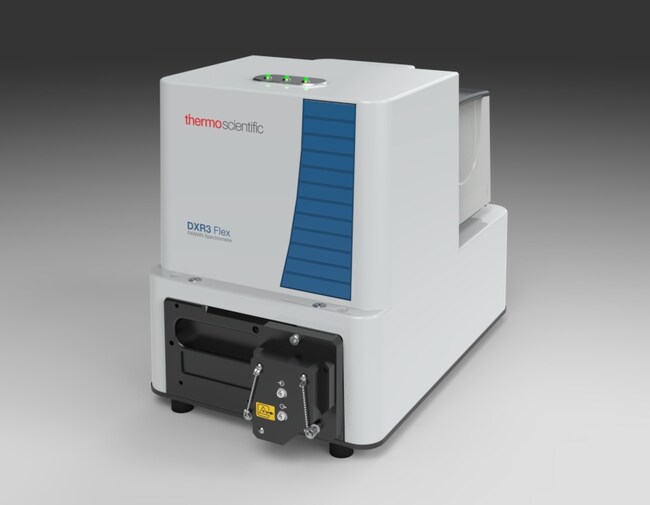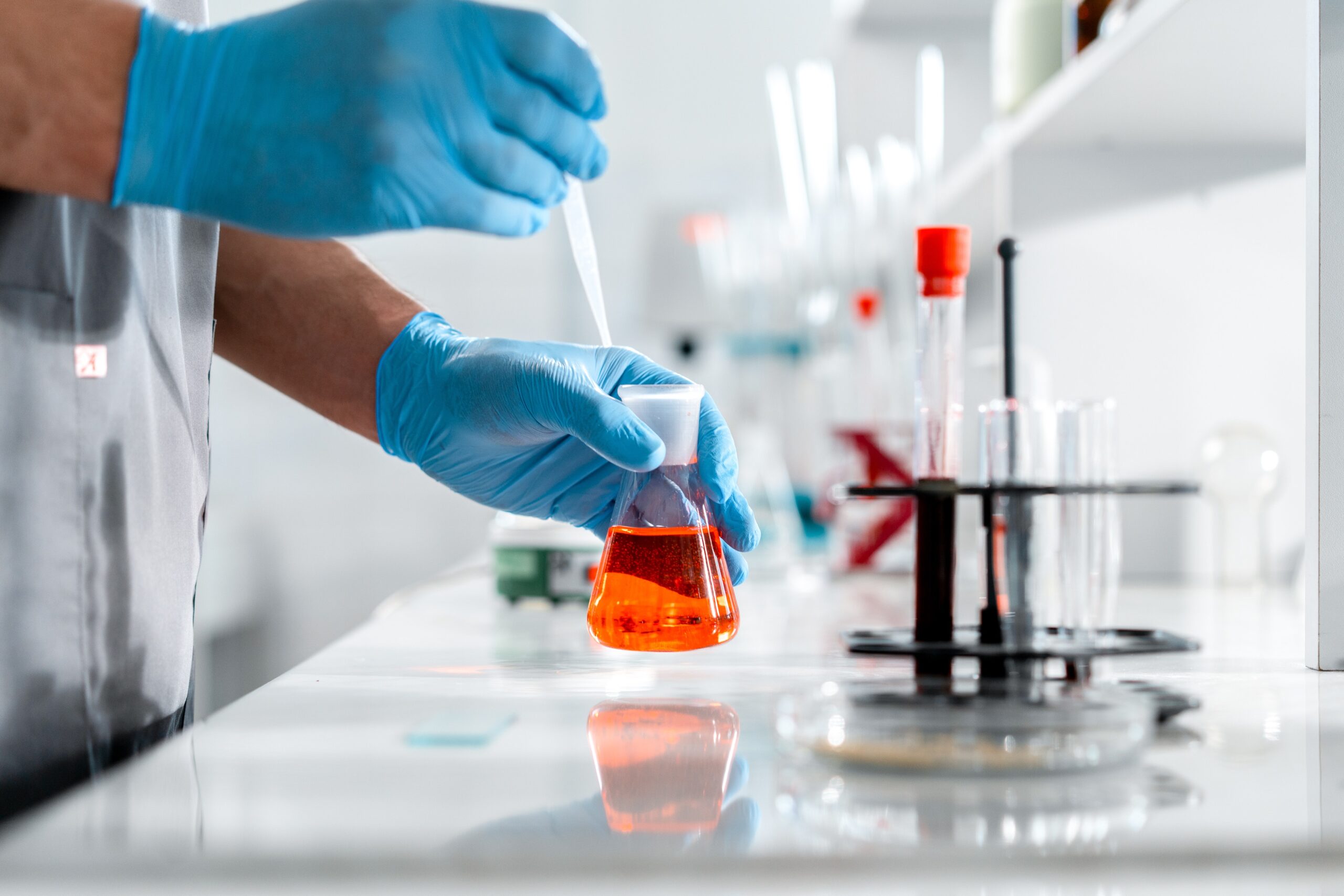Broaden your Raman analysis options

Expand the range of sampling capabilities with the new Thermo Scientific DXR3 Flex Raman Spectrometer. The DXR3 Flex offers you numerous sampling modes that allow for rapid, high-quality data capture on any number of samples. Options include a bulk material “macro” sampler, a single point microscope accessory with manual stage, and fiber optic probes.
Read below to find out more about the advantages of these sampling modes throughout various forensic sample analysis and their comprehensive range of sampling capability.
Comprehensive Raman Analysis of Forensic Samples
In the field of forensic analysis, material identification and analysis are critically important. But just as no pre-determined set of materials comprises all forensic lab analytes, there is no single method that is always employed to identify and study samples. Regardless of sample form, however, Raman spectroscopy provides valuable information about the molecular
structure of a vast array of materials (e.g., powders, paints, fabric, makeup, etc.) 1, 2. To expand the range of Raman spectroscopy’s analytical capabilities even further, the Thermo Scientific™ DXR3 Flex Raman Spectrometer offers numerous sampling modes that allow for rapid, high-quality data capture on any number of samples. This includes a bulk material “macro” sampler, a single point microscope accessory with manual stage, and fiber optic probes. All three sampling modes provide distinct advantages depending upon samples’ forms, shapes and sizes, but together they provide a truly comprehensive range of sampling capability.
A selection of some materials of interest were analyzed to build a representative picture of leveraging distinct sampling modes on various sample types. The samples and their analysis goals include:
• Quantifying the distribution of mixed powder samples.
• Identifying distinct brands and shades of lipstick, especially in situ on a cup.3
• Identifying distinct brands of duct tape.
• Identifying powdered particulate dissolved in alcohol.
The table below shows an overview of the various samples tested with each sampling mode where a check mark indicates a good analysis technique for that material:
Quantifying mixed powders
These samples are representative of the larger forensic need to identify unknown drugs and to both identify and quantify cutting agents. Precise peaks in the Raman signal of a mixed powder can be used to positively identify components of the mixture. Figure 2 shows various ratios (by volume) of acetaminophen and corn starch, along with spectra of pure
acetaminophen and corn starch for reference.
By taking ratios of these peaks relative to one another in a single spectrum, a calibration curve can be produced. This generates a quantifiable measurement that is true under any sampling conditions since each spectra references an internal standard. For the data in Figure 2, the calibration was built by taking the ratio of a peak unique to the acetaminophen spectrum (at 1169 wavenumbers) relative to one unique to corn starch (at 478 wavenumbers):
This calibration curve can then be used to quantify the ratio of acetaminophen to corn starch from any powder mix based solely on the Raman spectrum. The high R² value of the linear fit indicates very strong correlation in the samples. All three modes work well with these samples, although the macro sampler has the greatest spatial averaging and thus makes it ideal for bulk and averaged sampling
Identifying lipstick in situ

Raman spectroscopy has a significant advantage over many other techniques due to its non-destructive nature and minimal sample preparation needs. To leverage this even further,
fiber optic probes allow for sampling large objects that do not otherwise lend themselves to traditional analysis modes.
Representative of this is the identification of lipstick brands left on the surface of a cup.
Although the two identical lipstick shades from different brands display almost identical peak positions (aside from the peak at 300 wavenumbers), they have distinct and measurable peak ratios, especially in the three large peaks at 396, 514, and 637 wavenumbers and a unique peak at 297 wavenumbers.
For the purpose of identification, all three sampling modes are able to distinguish between the three sampled lipsticks. However, the fiber probe allows for non-destructive in situ measurements on materials that will not fit easily under a microscope or on the macro sampler—in this case with measurements taken directly on a cup.
Identifying additives in drinks
Not only does Raman spectroscopy allow for the identification of common forensic liquids (such as alcohols) but it can also identify trace additives in those liquids; this allows for the
identification of “spiked” drinks.

Liquid samples (in glass containers for these measurements) respond very well to the bulk sampling techniques of the macro sampling and fiber probe accessories. Trace liquids can be measured as individual drops under a microscope, but the small volume can affect the overall Raman signal, especially in attempting to identify a small amount of additive.
Identifying brands of duct tape
Specific material identification is very important, especially if it can distinguish between different brands of the same material. Different brands of duct tape were sampled on the outside, waterproofed surface.
Almost all duct tapes come in multiple colors and have indistinguishable surfaces, making a chemical identification of distinct structures in each brand’s formulation critical to
forensic identification. All three Raman sampling modes are able to distinguish between the brands of duct tape; the best fit depends on the size and shape of sample requiring analysis. For example, trace tape fibers would work best under the microscope accessory, while tape residue on a vehicle may be easiest to analyze with the free motion capabilities of the fiber probe
The DXR3 Flex Raman Spectrometer has the versatility to analyze the many types of potential forensic samples, thanks to multiple sampling accessories that can be changed by the user in minutes. Although the spectra collected here used a 785 nm excitation wavelength to address the inherent fluorescence of some of the samples, the spectrometer is compatible with 4 different excitation laser wavelengths
(at 455, 532, 633 and 785 nm). Shorter wavelengths result in greater Raman intensity for samples with lower signal-to-noise ratios and lasers are easily user-swappable (within minutes) in the system. Furthermore, the DXR3 Flex Raman Spectrometer has a small footprint, making it an ideal research-grade instrument to transport between lab spaces, thus allowing easy interfacing between Raman spectroscopy and other analytic forensic techniques.
This article is contributed by Thermo Fisher Scientific
Nexus Analytics is appointed as an exclusive distributor by Thermo Fisher Scientific in Malaysia and Singapore. We have vast experience and offer powerful analytical tools to help contract laboratories, research teams and regulators.
Want more information about Raman solution ?
Please fill up the form below. Our team will contact you as soon as possible. Thank you


